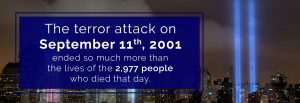
September 11, 2001 is a day that changed the world for all Americans. The terror attack ended so much more than the lives of the 2,977 people who died when terrorists overtook four airplanes, crashing:
- Two aircraft into the twin towers in New York City, NY
- One aircraft into the Pentagon in Washington, DC
- One aircraft into a field in Shanksville, PA — though the intended target of the terrorists was the U.S. Capitol building
REQUEST A QUOTE
The 9/11 date marks the end of dreams of parents, the childhoods of approximately 3,051 children who lost a parent during the attack and the relative innocence of a nation that had not faced a direct attack from foreign aggressors since December 7, 1941 — when Japanese forces launched a sneak attack on Pearl Harbor.
The difference this time was perhaps more palpable, though, as America watched in horror, while drinking coffee and eating breakfast, as first one tower, then another tower fell to the ground.
The world changed that day. It will never be the same again.
Changes in Airport Security
One of the places those changes are most obvious is in any U.S. airport. From the creation of the TSA to the use of airport blast shields, below you will learn about the many changes that have occurred since 9/11 and directly changed the way people travel in the U.S.
The TSA Was Created
On November 19, 2001, the Transportation Security Administration, commonly referred to as the TSA, was created as a direct response to the 9/11 attacks. The agency, operating under the umbrella of the U.S. Department of Homeland Security was tasked (and still is) with securing and safeguarding U.S. travelers while traveling throughout the United States and to international destinations.
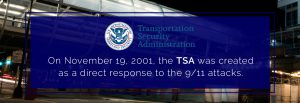
The philosophy behind the TSA is that the freedom to travel without the worry of a terrorist attack is one of the fundamental freedoms all Americans deserve and should have. Most people only associate the TSA with the agents who conduct screenings that allow passenger entry into the part of the secure areas of the airport – though the agency does that and so much more.
While primarily concerned with air traffic, the TSA has authority over security relating to the additional following modes of travel and transportation:
- Highway travel
- Rail travel
- Bus travel
- Mass transit travel
- Pipeline security
- Ports
The job of the TSA is to ensure freedom of movement — not only for the people who travel, but also the commerce that travels and is transported across the nation on roadways, waterways and rivers. The TSA protects these items and travelers whether they are going by air, railway, motor vehicle or ship. The ultimate goal of the agency is to ensure attacks against national interests, like those that took place on September 11, 2001, never happen again.
Check Out Our Blast Containment Tank for Your Security Needs
Only Ticketed Passengers Can Enter Secure Airport Areas
Once upon a time, families and friends could enter into the secured areas of the concourse to see their loved ones off or be the first to greet them when they arrived back home. This allowed families to remain together until the last minute and gave loved ones an opportunity to watch as their relative's or friend's flights departed or arrived.
That changed with 9/11 and the introduction of TSA screening, which allowed only ticketed passengers to be admitted into the secure areas of the airport. For those who didn't do much flying prior to 9/11, it may not seem like a big deal, but for many parents, spouses, brothers, sisters and friends, it was one of the most notable and disliked initial changes.
Changing the Design of Airports
The new U.S. air travel security issues also forced many airports to change the way they were configured. In many cases, this required upgrades to change the actual construction of the airports and their facilities.
Along with new airport construction, there were a few less visible, but equally important, changes made in the design of airports, including things like airport blast walls to guard against a wide variety of unforeseen events. After 9/11, new rules were established regarding parking structures that could no longer be located within a 300-foot radius of airport terminals.
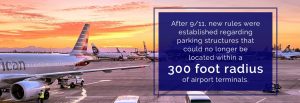
Parking lot blast shields are one of the few cost-effective additions to airport parking structures that may grant air transportation waivers to the rule. However, it's evaluated on an individual basis for all airports who seek to use this tool for keeping airport passengers and guests safe.
Learn More About Protecting Airports Using Blast Shields
From airport blast shields to tighter security screenings and new facility layouts designed to protect the masses, airports are taking your safety seriously.
Protecting the Pilots and Cockpit
The air travel security changes while flying haven't only taken place in airports. Today's passenger jets have cockpits that have been equipped with bullet-proof doors that lock from the inside. Sealing off the cockpit for the duration of the flight keeps the pilot and co-pilots behind impregnable doors in hopes of preventing future scenarios whereby a pilot would be incapacitated in an attack similar to 9/11.
Passengers also cannot enter the cockpit once the flight commences. This is in contrast to pre-9/11 and a sad day for children who once adored the opportunity to meet the pilot and get their “wings” during the long, boring flight.
Further, under the Federal Flight Deck Officer program, pilots are permitted to carry guns as long as they have the proper training.
The intention of this program is to allow eligible crew flight personnel to:
- Defend the flight deck if crime is occurring.
- Defend the flight against air piracy.
To be eligible, in addition to being a U.S. citizen, interested crew must maintain a current FAA airman's certificate, and have a current medical class 1 or class 2 certificate. Flight deck officers are also trained in the use of force to guard against individuals who are attempting to take over the control of the flight deck.
This program, which was directed by the TSA, was established following 9/11 as a component of the Homeland Security Act of 2002 under the Arming Pilots Against Terrorism Act.
Increased U.S. Federal Marshal Presence
While the U.S. Federal Air Marshals Service (FAMS) have been a part of American aviation since 1962, it has become more visible since September 11. In 2001, there was reportedly fewer than 100 air marshals. Today, it's estimated that our FAMS workforce is around 5,000.
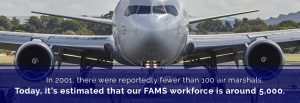
Air marshals aren't on every flight, however, considering that there are approximately 30,000 U.S. commercial flights per day. Instead, federal air marshals are strategically placed on certain flights. Which flights get federal air marshals is decided by a number of factors, including a computer algorithm that evaluates the threat on a particular flight based upon such elements as:
- Aircraft type
- Departure city
- Destination city
- Amount of aircraft fuel on board
Security Screening Procedures
It isn't just that you must go through security screenings before entering certain areas of the airport today that has changed. The scale and scope of these screenings has also changed. Gone are the days of jovial delays while one man obsessively seeks out the one key chain or silver coin that had set off a scanner.
Today's scans often involve a full-body look using advanced and sophisticated imaging technology. If something suspicious is found on the scan, you could be asked to let a TSA officer give you a pat down. What's more, bomb-sniffing dogs are often found in security checkpoint waiting lines to sniff out explosives and speed up security lines.
These are some of the other post 9/11 security rules in terms of what passengers are allowed to bring through security checkpoints.
- No one is permitted to bring box cutters, Swiss army knives, multi-tools, pocket knives and even some types of scissors on modern flights.
- No bags are excluded from screening, which means people are being far more judicious about what is placed in carry-on bags and checked bags alike.
- No liquids are allowed to be brought through security checkpoints if they don't fit in a TSA approved quart-sized bag and contain three ounces or less of liquid. Many passengers have taken to bringing refillable water bottles along with them and emptying on one side of the checkpoints then refilling at fountains on the other side.
Passenger Time Increased at Airports Before Flights
Security procedures today take much longer than in years past with everyone going through a more thorough screening. In fact, screenings have been heavily criticized in recent months for agencies operating with less than adequate staff, leaving busy airports operating with excessively long lines.
Perhaps the most notable and frustrating of inconveniences are for business that rely on airline travel for employees and the need for passengers to arrive up to two hours — or longer — before their scheduled departure just to make it through all the screening procedures. This need alone costs businesses money because they must pay their employees for time that is spent waiting in lines at the airport, rather than producing for the company.
While everyone wants to be safe while flying, some people are beginning to express ire over the increased scrutiny, enhanced pat downs, full-body scans and other invasive security procedures. Long airport screenings have caused some air travelers to miss their flights and precipitated a hashtag trend for #ihatethewait as recently as May of 2016.
Many airline passengers have even changed the way they dress for flights to avoid unnecessary entanglements in the security lines. They often wear slip on shoes — or at the very least, they opt for footwear that is easy to put on and remove since shoes must be scanned today, too.
Better Training for Security Personnel
One of the alarming facts to come out in the aftermath of the 9/11 attacks was that four of the hijackers set off the metal detectors. After being wanded, the men were subsequently allowed to go through and board their planes with what, according to surveillance footage, appears to be box cutters clipped to the outsides of their pockets, consistent with what was used in the attacks.
Scanning and screening procedures have become far more thorough in the days since 9/11 and the training for TSA officers is far more rigorous. Most passengers go through what is essentially an X-ray device before boarding a plane or entering the secured areas of the airport.
Not only are all security officers at the many airports across the country better trained to identify and address threats, but they are also being better screened.
The TSA is supplementing these tighter security checks with other checks and balances to ensure passenger safety on flights, such as double checking suspicious passengers with FBI databases and other watch lists and educating passengers on how to be watchful and mindful of their own security. Passengers on the ground are also advised to be on the lookout of suspicious people and packages.
According to the International Foundation for Protection Officers airport screeners have confiscated more than 7.8 million items since February of 2002, including the following:
- Firearms (1,437)
- Knives (2.3 million)
- Box Cutters (49,331)
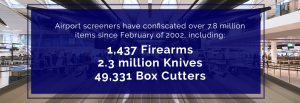
Real ID
One post 9/11 change is in the works, but it hasn't come into full effect. It is the Real ID requirement. Not all states are compliant yet, and some may not be by the time Real ID requirements for air travel go into full effect.
The requirement is that people who fly domestically or internationally will be required to present Real ID-compliant identification — either in the form of a state ID, enhanced driver's license or a passport by January 22, 2018.
So, what is Real ID? At its simplest, Real ID establishes a nationwide standard for issuing identification. One of the key recommendations of the 9/11 commission was to adopt a nationwide standard for identification, a determination that was once left to different states to decide. The Real ID Act established a minimum security standard for state-issued identification cards and driver's licenses. It also prohibits Federal agencies from accepting identification cards and licenses and from states that do not meet these standards for official purposes.
TSA Pre-Check
The TSA is now allowing passengers the ability to go through a one-time pre-check screening process designed to save passengers time and stress during the boarding process. The program offers a five-year membership at a current cost of $85.
This pre-check provides many perks to fliers, including no longer needing to take off shoes or light jackets, take out laptops, dump liquids or remove belts when going through airport screening. The initial screening is quite thorough and rigorous — and involves an FBI background check — but it provides people who fly often a viable alternative to the long wait lines and general headaches of traditional airport screenings.
The Changes May Be an Inconvenience, but They Help
The bottom line is this: It is true that the world has changed in the aftermath of the attacks that took place on September 11, 2001. Flying, perhaps more than anything else, has changed immeasurably. These changes, while sometimes uncomfortable, frustrating and inconvenient, have all been made with the safety and security of everyone flying today in mind. To date and since 9/11, there has not been a successful terrorist attack on U.S. aircraft.
Not only do these changes allow you to fly more securely, but they also allow you to fly with greater peace of mind that there are tools in place to better ensure your safety both in the air and on the ground. The changes above are just a few that have made that happen.
If you are looking to improve the safety of your facility through blast shields, blast walls or other ballistic products, contact us at T.M. International, LLC at 718-842-0949.




